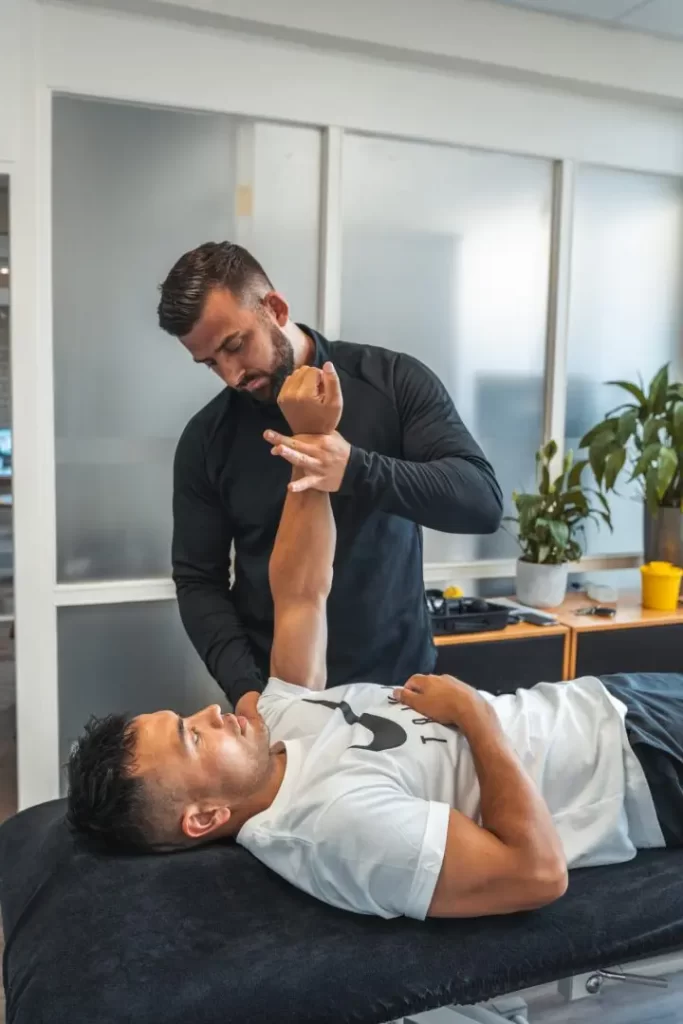Cyclops (arthrofibrosis)
Cyclops also known as arthrofibrosis is caused by scar tissue in the knee often after anterior cruciate ligament surgery. The symptoms are often described as a pain at the front of the knee that interferes with full mobility. A cyclops occurs in an average of 5% of all people after anterior cruciate ligament reconstruction. Stretching the knee is particularly painful and sometimes there is an audible click described in English as "clunck". These symptoms usually arise between 8 and 32 weeks of the rehabilitation process. The exact mechanism of origin is not yet clear. Possibly the scar tissue is a result of drilling the tunnels for the new anterior cruciate ligament, wedging of the graft between the tibia and femur, irritation due to residual fibres of the original anterior cruciate ligament occupying space in the joint. Either way, there is a mass of scar tissue taking up too much space in the knee and impeding function. The size of this scar tissue can vary between 3×5 mm to 8×12 mm

Possible causes of cyclops
Some causes and factors, which come into play in a cyclops:
- Female due to less space in the knee joint
- Increased volume of graft relative to notch
- Bony avulsion of anterior cruciate ligament (VKB)
- Bony avulsion of anterior cruciate ligament of femur
- Anterior placement of tibial tunnel
- Double-bundle VKB reconstruction due to larger volume of graft
- Bicruciate -preserving arthroplasty due to VKB injury or acute tibial bone island
- Hamstring contracture
Possible symptoms in cyclops
- Pain at the front of the knee
- Problems walking and picking up speed (running)
- An audible click while stretching the knee
- Less mobility
- A hard end feeling when stretching the knee
- Impaired function of the quadriceps (upper leg muscle)
- Swelling present in the knee(hydrops)
* This is after the acute phase. For the first 3 months, these symptoms are due to the surgery and not due to possible cyclops in the knee.
Further examination by MRI
As with other complications in the knee, an MRI can be conclusive about the symptoms experienced. When a cyclops is present, scarring is visible at the front of the knee joint. Specifically at the attachment of the new anterior cruciate ligament to the lower leg (intercondylar notch at the insertion of the tibia). Studies show that cyclops in the knee increases after anterior cruciate ligament surgery. 25% of people have cyclops in the knee after 6 months. This number rises to 33% 2 years after anterior cruciate ligament surgery. Cyclops or scar tissue is normal after anterior cruciate ligament surgery. It only becomes problematic if the mass is large enough to cause symptoms.
Figures and opportunities
Cyclops occurs approximately in 4% of anterior cruciate ligament operations. It is characterised by the inability to stretch the knee properly. We usually see this around 2-3 months after surgery. Before that, it is normal not to be able to stretch the knee properly due to the sensitivity of the knee after surgery. We often see dormant irritation of the knee joint as a result of cyclops. This then manifests itself particularly in a stretch limitation, swelling in the knee, poorer control of the quadriceps. If the symptoms do not subside, a decision may be made to surgically remove the cyclops in consultation with the doctor.
Conclusion
Around 1 in 10 people after anterior cruciate ligament surgery experience cyclops in the knee. It is important to intervene in time. This is so as not to delay too much within rehabilitation. Precious time can be lost if it is not spotted in time. Treatment of cyclops is only necessary for symptomatic lesions. That is, pain symptoms and restrictions are present with scar tissue in the knee large enough to cause problems.
In some cases, the treating doctor may opt for an MRI or keyhole surgery to confirm the diagnosis. If necessary, the choice may be made to surgically remove the cyclops. In fact, physiotherapy does not affect the cyclops. The task of the physiotherapist is to recognise cyclops and inform the treated orthopaedic surgeon.
Surgical removal of a cyclops often gives good results. Pain decreases, range of motion increases and rehabilitation can resume as planned.
Making an appointment at FysioFitaal
We work from multiple locations in Tilburg, always close by for professional and accessible physiotherapy. Fill in the contact form and we will contact you soon. Together, we will work on your recovery!

